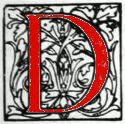
Frontispiece and title-page. Elementary Instruction on the Art of Illumination (1848) by David Laurent de Lara (active 1850s & '60s). Each page 11.7 x 18.2 cm. This item was catalogue no. 53 in Beckwith, Victorian Bibliomania (1987). [Click on image to enlarge it.]
Commentary by Alice H. R. H. Beckwith

avid Lauent de Lara's manual of illumination seems at first glance to make appropriate bows to Gothic Revival interests in architecture and book design, because it is bound with a visually charming black and red striped cloth suggesting Italian Gothic brickwork. Furthermore, it is gold-stamped with a facsimiled fourteenth-century illuminated border around the simplified title, Instruction in Illumination and Missal Painting. The cover was probably designed by the publisher, Ackermann, or his staff. The gold-edged pages of the text reveal that while the author was good at advertising himself and his book, he was less than gifted as an illuminator and confused in his understanding and appreciation of the art. Laurent de Lara is probably the ignorant "unprincipled adventurer" whom J. Willis Brooks accused of taking advantage of lady illuminators in "depressed circumstances" (Brooks, ii).
Laurent de Lara presents himself as the "only Artist who has offered to instruct Amateur Illuminators," while criticizing Henry Noel Humphreys's Illuminated Books of the Middle Ages as being too elaborate for the beginner. He does not mention Humphreys's The Art of Illumination and Missal Painting (cat. 52), published the year before, nor does he credit Humphreys with originating the format of the illuminators' manual. Laurent de Lara had some justification in saying that a book for amateur illuminators was a new idea, since Humphreys described the modern illuminator as a professional paragon of the arts (see cat. 52).
Collaboration between authors of small inexpensive manuals of illumination and many of the major producers of watercolor paintboxes resulted in a flood of such such books by the 1860s, including this book, which advertises Ackermann's color boxes. Other manuals by Winsor and Newton, George Rowney and Company, and J. Barnard and Son were for the most part more informative and better designed than Laurent de Lara's work (cats. 54, 56-58). Problems with de Lara's instructions and his designs stem from his insensitivity to the page as an interrelated field upon which a unity is created of text and illuminated ornament. He instructs his readers on page 6 that "beauty of illuminated drawing consists of nicety of execution, elaborate ornamental detail, and the mathematical precision with which ornaments are frequently repeated throughout the same design."
The case against Laurent de Lara rests upon his less than accomplished drawings and his involvement with the women's employment movement by 1864, when the seventh edition of his manual was published by Longman, Green and Co. in a format which even he admitted was less appealing than earlier editions of his book. The seventh edition does not have Ackermann's handsome binding or the elegant fifteenth-century head and tailpieces and initials of the 1850 edition. The Bodleian Library at Oxford owns a copy ot the seventh edition, and in it direct references are made to ladies in "depressed circumstances." In an advertisement for the Illuminating Art Union of London, we learn that Laurent de Lara was the manager of the Union, which was instituted in 1857 to "afford employment to the educated gentlewoman of limited means." Patronesses of the Union subscribed £1/1s. per year "for which an 'original Vellum Illumination' executed by the less affluent members" was an annual premium. Brooks characterized this bluntly as a program to persuade lady illuminators "to place their excellent taste and skill, for worse than starvation prices, at the disposal of some unprincipled adventurer, ignorant himself of the very rudiments of the art he professes to teach" (Brooks, ii).
Other advertisements inside the first flyleaf of the seventh edition tout the Albert Lithographic Printing Office, as established to promote "Female Employment," and E. Fuller and Co., who describe their chromolithographic works as "the artistic branch of lithography wholly carried out by females." Significantly, in this edition Laurent de Lara changed the dedication of his manual from Lady Augusta Cadogan to Lady Harriet Ashley, the daughter-in-law of Lord Shaftesbury. The years during which Laurent de Lara was actively involved with women's employment (1857-1864) were times of significant activity involving Lord Shaftesbury and women in the printing industry (Herstein 140-44).
You may use this image without prior permission for any scholarly or educational purpose as long as you (1) credit the Internet Archive and the Sterling and Francine Clark Art Institute and (2) link your document to this URL in a web document or cite the Victorian Web in a print one.]
References
Beckwith, Alice H. R. H. Victorian Bibliomania: The Illuminated Book in Nineteenth-Century Britain. Exhibition catalogue. Providence. Rhode Island: Museum of Art, Rhode Island School of Design, 1987.
Brooks, J. Willis. “Introduction” in Freeman Gage De la Motte, Medieval Alphabets and Initials for Illuminators. London: C. Lockwood & Co., 1864.
Herstein, Sheila R. A Mid-Victorian Feminist, Barbara Leigh Bodichon. New Haven: Yale University Press, 1985.
Laurent de Lara, David. Elementary Instruction on the Art of Illumination and Missal Painting on Vellum: with Illustrations for Copying for the Student. London: Ackermann & Co, 1850. Internet Archive version of a copy in the library of the Sterling and Francine Clark Art Institute. Web. 22 December 2013. [The copy of this book in the 1987 exhibition the copy came from the Yale Center for British Art.]
Last modified 22 December 2013